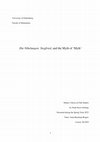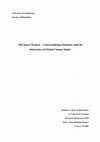Papers by Noak Snow Gröning
What's in a word? In both Ray Bradbury's The Martian Chronicles (1950) and Joanna Russ's The Fema... more What's in a word? In both Ray Bradbury's The Martian Chronicles (1950) and Joanna Russ's The Female Man (1975), it is through language that the central conflicts of both novels emerge. On a superficial level, these conflicts are a question of an intrinsic duality: Martians and Earthlings on the one hand, and women and men on the other. Dig deeper, however, and the conflict reveals itself to really be a question of contemporary societal conceptions of reality clashing with those aspects of reality which that conception in itself cannot abide, meaning those things which a 'normative' construction of the world does not includea reified lie which has language serving as its most primary foundation.

GUPEA, 2022
This paper sets out to critically discuss and analyse both the scholarly and general implementati... more This paper sets out to critically discuss and analyse both the scholarly and general implementation of the word 'myth' as designator of style, narrative, and cultural significance, within film studies and adjacent academic fields. This is done through an examination of scholarly discourse surrounding the topics of mythology, folk tale, and fairy tale, specifically in regard to Fritz Lang's film Die Nibelungen: Siegfried (1924), and, albeit to a lesser extent, its sequel Die Nibelungen: Kriemhild's Rache (1924). Studies of folkloric narratives within other disciplines are also considered, particularly those that have exercised direct influence on the development of film criticism, such as psychoanalysis. Finally, drawing on film studies, folkloristics, and literature studies, the most prominent parts of this text provide analysis of Die Nibelungen in the light of this discourse.

This essay represents an attempt to further the understanding of the films by Japanese New Wave d... more This essay represents an attempt to further the understanding of the films by Japanese New Wave director Shohei Imamura through the use of post-colonial theory, and political and cultural contextualisation; it also offers discussion on the inherent issues of discussing non-Western cinema from a Western point-of-view, and how post-colonial theory can be used tentatively by Western writers to prevent the perpetuation of orientalism and the generalisation of non-Western cultures as a single entity simply titled 'the Other'. This is done through an in-depth exploration of Western film theory's problematic relationship to Asian cinema, along with disposition and historical contextualisation relevant to Imamura's films and the Japanese New Wave movement of the 1960s. This is then followed by an analysis on Imamura's sixth film, The Insect Woman, released in 1963, in which I implement post-colonial theory while also comparing it to Yasujiro Ozu's 1951 motion picture Early Summer, a film which addresses similar themes but in widely different ways. (1961), Shohei Imamura's Pigs and Battleships (1961), and Oshima's own The Sun's Burial (1960). One of the most notable names to arise from this set of directors is that of Shohei Imamura, who first achieved critical acclaim in his homeland with his fourth film, Nianchan (My Second Brother, 1959, aka The Diary of Sueko). Like his contemporaries, Imamura's early films were made within the commercial confines of the studio system, (indeed, many, if not most, of the New Wave directors worked within studio systems, at least during the earlier parts of their careers) several of which were youth films, a genre of films which had at the time become something of a defining characteristic for the studio which Imamura worked for, that being Nikkatsu Studios (commonly regarded as one the most commercially inclined Japanese studios of its time) 3. However, starting with his fifth film, Buta no Gunkan, or Pigs and Battleships, Imamura went on to direct a number of films centring on the lives and livelihoods of Japanese lower-class women, effectively distancing his works from the generally far more male-centric narratives of his peers. Out of the seven films Imamura directed during the span of the New Wave, four of themthese being Pigs and Battleships, The Insect Woman (1963), Intentions of Murder (aka Unholy Desire, 1964) and The History of Postwar Japan as Told by a Bar Hostess (1970)all feature women in leading roles, and focus specifically on the personal lives and perceived gender roles of women in Japanese postwar society, whereas the remainder of his 60s output, which includes The Pornographers-An Introduction to Anthropology (1966), A Man Vanishes (1967) and The Profound Desire of the Gods (1968), still treat societal aspects such as female sexuality, female independence, and mother roles, as central themes. The second of these, and Imamura's sixth film overall, here in the West titled The Insect Woman (originally titled Nippon Konchûki, or Entomological Chronicles of Japan), is the first of his films to dedicate the entirety of its narrative to the exploration of a single female main character (Pigs and Battleships implemented both a male and a female protagonist). Thematically, the film deals primarily with the political and social changes that occurred in Japan from the Taisho era (1912-1926) all the way to the early sixties as reflected in the life of its main character, Tome, who repeatedly attempts to adapt and find a life of happiness in a country of constant and rapid transformation, all the while being torn between her own search for individuality and the desires of her extremely conservative family. It is this inner conflict resulted in an academic dispute on just how much Ozu was, if at all, truly influenced by American cinema, acutely summarised here by Yoshimoto: Paul Willemen criticizes Bordwell and Thompson by saying that to call Ozu a modernist is not so much different from European modernist artists' questionable appropriation of African tribal sculpture in the early twentieth century. Bordwell responds that Willemen's critique does not hold, since African sculptors never saw modernists' art work, but Ozu was thoroughly familiar with the Hollywood cinema. Lehman intervenes in this skirmish and takes side with Willemen. According to Lehman, Bordwell dismisses too easily the similarities between traditional Japanese art and Ozu's films, both of which, as Joseph Anderson points out, construct discontinuous, non-narrative space. 5 Despite praising the astuteness of Lehman's critique, Yoshimoto nevertheless goes on to castigate Lehman as well as Willemen for their 'Eurocentric view of modernism, which does not consider what modernism possibly means for the non-West.' Finally, he states: A seemingly innocent question of Ozu's modernity, in fact, cannot be answered unless we carefully take into account the specificities of Japanese cinema, social formations, and history. Such a problematic in Japanese or non-Western scholarship will finally lead to many more fundamental questions concerning the definitions of nation and of a cinema. 6










Uploads
Papers by Noak Snow Gröning